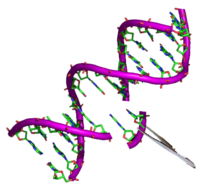
Photo from wikipedia
Background To date, the pathogenesis of Alzheimer’s disease is still not fully elucidated. Much evidence suggests that Ferroptosis plays a crucial role in the pathogenesis of AD, but little is… Click to show full abstract
Background To date, the pathogenesis of Alzheimer’s disease is still not fully elucidated. Much evidence suggests that Ferroptosis plays a crucial role in the pathogenesis of AD, but little is known about its molecular immunological mechanisms. Therefore, this study aims to comprehensively analyse and explore the molecular mechanisms and immunological features of Ferroptosis-related genes in the pathogenesis of AD. Materials and methods We obtained the brain tissue dataset for AD from the GEO database and downloaded the Ferroptosis-related gene set from FerrDb for analysis. The most relevant Hub genes for AD were obtained using two machine learning algorithms (Least absolute shrinkage and selection operator (LASSO) and multiple support vector machine recursive feature elimination (mSVM-RFE)). The study of the Hub gene was divided into two parts. In the first part, AD patients were genotyped by unsupervised cluster analysis, and the different clusters’ immune characteristics were analysed. A PCA approach was used to quantify the FRGscore. In the second part: we elucidate the biological functions involved in the Hub genes and their role in the immune microenvironment by integrating algorithms (GSEA, GSVA and CIBERSORT). Analysis of Hub gene-based drug regulatory networks and mRNA-miRNA-lncRNA regulatory networks using Cytoscape. Hub genes were further analysed using logistic regression models. Results Based on two machine learning algorithms, we obtained a total of 10 Hub genes. Unsupervised clustering successfully identified two different clusters, and immune infiltration analysis showed a significantly higher degree of immune infiltration in type A than in type B, indicating that type A may be at the peak of AD neuroinflammation. Secondly, a Hub gene-based Gene-Drug regulatory network and a ceRNA regulatory network were successfully constructed. Finally, a logistic regression algorithm-based AD diagnosis model and Nomogram diagram were developed. Conclusion Our study provides new insights into the role of Ferroptosis-related molecular patterns and immune mechanisms in AD, as well as providing a theoretical basis for the addition of diagnostic markers for AD.
Journal Title: Frontiers in Aging Neuroscience
Year Published: 2022
Link to full text (if available)
Share on Social Media: Sign Up to like & get
recommendations!